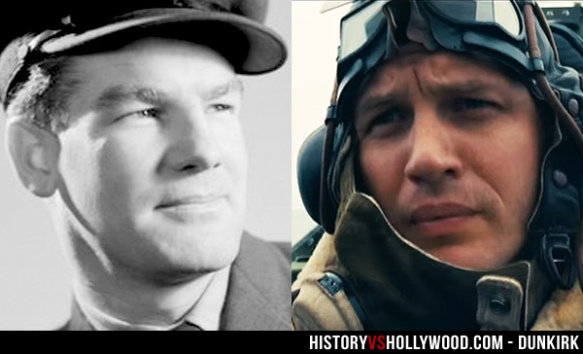Tom Hardy’s character’s experience in the Dunkirk movie most closely resembles that of New Zealand Spitfire pilot Alan Christopher Deere.
Dunkirk (2017) History vs. Hollywood
When Allied defense against the German FALL GELB operation broke, London organized Operation DYNAMO: a desperate withdrawal of 340,000 British, Commonwealth, and other Allied (120,000 French and 20,000 Belgian) troops from the beaches and port of Dunkirk. The operation lasted from May 25 to June 2, 1940. Many clamored aboard rescue ships without even basic equipment, while all tanks, trucks, and heavy weapons were abandoned on the beaches. This massive amphibious retreat was made necessary by a German breakthrough that split the British Expeditionary Force (BEF) and some French and Belgian divisions from the rest of the French Army which forced surrender by Belgium on May 28. There was significant misunderstanding and hostility at first between British and French troops in the enclave, as most of the French who were evacuated were not embarked until nearly all British troops had already left. The main reason was that the French High Command refused to accept the need for any evacuations until after the Belgian surrender on May 28, but later used the British evacuation as an excuse for military failure and signature of the armistice on June 22.
The evacuation was accomplished with the aid of hundreds of civilian craft of all types and sizes, the famed “Little Ships” that included personal yachts, London river barges, and fishing vessels. But mainly it was carried out by Royal Navy minesweepers, destroyers, and other warships. A heroic rearguard defense was made by elements of French 1st Army and selected British and Canadian units, while the RAF fended off Luftwaffe attacks on the beaches and ships and the Royal Navy fought off German E-boats. The RAF lost nearly 200 fighters over nine days defending the Dunkirk enclave; the Luftwaffe lost 240 planes attacking it. The Allies also lost 9 large warships ships and 9 destroyers, with 19 more destroyers damaged. Daylight ship runs stopped on June 1. Another 60,000 French troops and elements of the British perimeter force were evacuated under cover of night on June 2.
Escape of over 320,000 enemy soldiers from Dunkirk was made possible by Adolf Hitler`s “stop order.” For two critical days, May 24-25, he forbade Panzer forces to pursue a retreating and badly demoralized enemy. But it is important to note that the generals of the OKH agreed with Hitler: their attention was drawn south to what they believed would be a large battle in front of Paris. Hitler and the OKH alike wanted to preserve worn and tired Panzer divisions for that fight and to let slower arriving German infantry and the Luftwaffe finish the job along the coast. About 120,000 British troops remained in France after Dunkirk. Smaller evacuations got some men out, but most of the 51st Highland Division was compelled to surrender on June 12. Over 156,000 British, Canadian, and Polish troops were then evacuated from Cherbourg. although 3,000 died when their departing liner was bombed by the Luftwaffe just off the French coast. Behind the German lines, Wehrmacht and Waffen-SS carried out several massacres of French civilians-a sign of occupation practices to come. There were also instances along the perimeter of British troops shooting unarmed or individual surrendering Germans. Dunkirk was not the first time that British forces were chased from Europe by the Wehrmacht and forced into desperate evacuation by sea-British failure in northern Norway was contemporaneous. More dark days and forced amphibious departures from Greece and Crete still lay in the future for the British Army and its Commonwealth and minor European allies. And as Churchill told the House of Commons on June 4: “Wars are not won by evacuations.”
RAAF
France, the battle launched on 10 May 1940 when German forces attacked through Holland, Belgium and Luxembourg, and forced the capitulation of France on 22 June. Some 40 Australian airmen took part in this brief campaign as members of Royal Air Force squadrons, and ten of them were lost in action. Three were killed while flying protective sorties over the Dunkirk beachheads during the evacuation of the British Expeditionary Force in late May and early June. While none of these pilots were in formed units of the Royal Australian Air Force or retained a formal association with that service, many had received their initial flying training in the RAAF before being seconded (and then usually transferred) to the RAF.
Under these arrangements, the pilots concerned were permitted to wear out their RAAF uniforms before being required to replace them with RAF clothing. It is recorded that at least one man, Flying Officer Leslie Clisby, was still wearing his RAAF tunic-although in an advanced state of disrepair-when shot down over Neuville, France, on 14 May. At the time of his death, Clisby was officially credited with having destroyed fourteen enemy aircraft in combat (his unofficial tally was reportedly nineteen, and possibly higher). Awarded the Distinguished Flying Cross, Clisby was arguably the first `Australian’ air ace of the Second World War.
Lex McAulay (1991) Six Aces: Australian Fighter Pilots 1939-45, Brunswick, Vic.: Banner Books
